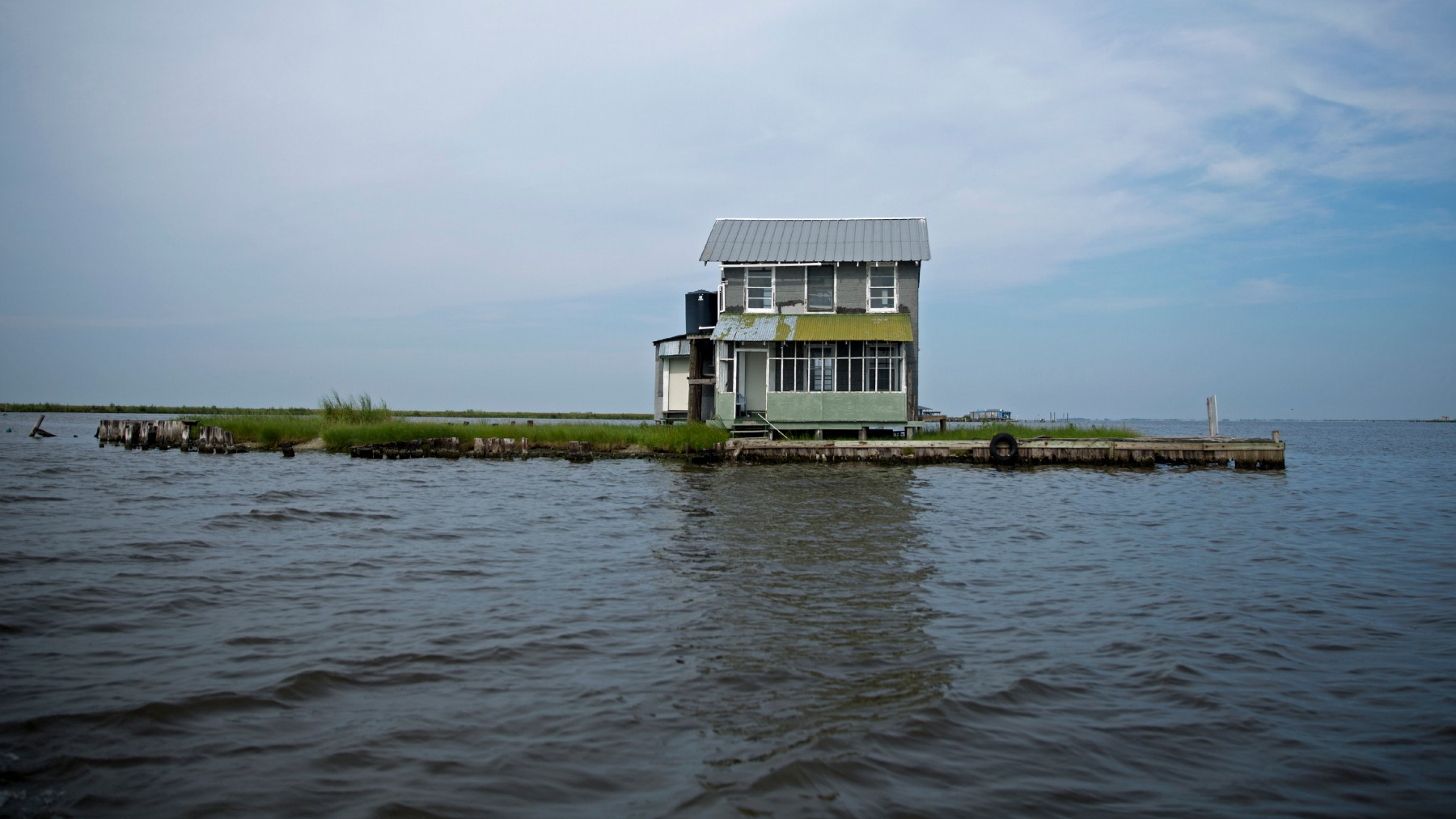In just 80 years, some 2,000 square miles of its coastal landscape have turned to open water, wiping places off maps, bringing the Gulf of Mexico to the back door of New Orleans and posing a lethal threat to an energy and shipping corridor vital to the nation’s economy.
And it’s going to get worse, even quicker.
Scientists now say one of the greatest environmental and economic disasters in the nation’s history is rushing toward a catastrophic conclusion over the next 50 years, so far unabated and largely unnoticed.
At the current rates that the sea is rising and land is sinking, National Oceanic and Atmospheric Administration scientists say by 2100 the Gulf of Mexico could rise as much as 4.3 feet across this landscape, which has an average elevation of about three feet. If that happens, everything outside the protective levees — most of Southeast Louisiana — would be underwater.
The effects would be felt far beyond bayou country. The region best known for its self-proclaimed motto “laissez les bons temps rouler” — let the good times roll — is one of the nation’s economic linchpins.
This land being swallowed by the Gulf is home to half of the country’s oil refineries, a matrix of pipelines that serve 90 percent of the nation’s offshore energy production and 30 percent of its total oil and gas supply, a port vital to 31 states, and 2 million people who would need to find other places to live.
The landscape on which all that is built is washing away at a rate of a football field every hour, 16 square miles per year.
For years, most residents didn’t notice because they live inside the levees and seldom travel into the wetlands. But even those who work or play in the marshes were misled for decades by the gradual changes in the landscape. A point of land eroding here, a bayou widening there, a spoil levee sinking a foot over 10 years. In an ecosystem covering thousands of square miles, those losses seemed insignificant. There always seemed to be so much left.
Now locals are trying to deal with the shock of losing places they had known all their lives — fishing camps, cypress swamps, beachfronts, even cattle pastures and backyards — with more disappearing every day.
Fishing guide Ryan Lambert is one of them. When he started fishing the wetlands out of Buras 34 years ago, he had to travel through six miles of healthy marshes, swamps and small bays to reach the Gulf of Mexico.
“Now it’s all open water,” Lambert said. “You can stand on the dock and see the Gulf.”
Two years ago, NOAA removed 31 bays and other features from the Buras charts. Some had been named by French explorers in the 1700s.
The people who knew this land when it was rich with wildlife and dotted with Spanish- and French-speaking villages are getting old. They say their grandchildren don’t understand what has been lost.
“I see what was,” said Lloyd “Wimpy” Serigne, who grew up in the fishing and trapping village of Delacroix, 20 miles southeast of New Orleans. It was once home to 700 people; now there are fewer than 15 permanent residents. “People today — like my nephew, he’s pretty young — he sees what is.”
If this trend is not reversed, a wetlands ecosystem that took nature 7,000 years to build will be destroyed in a human lifetime.
The story of how that happened is a tale of levees, oil wells, and canals leading to destruction on a scale almost too big to comprehend — and perhaps too late to rebuild. It includes chapters on ignorance, unintended consequences and disregard for scientific warnings. It’s a story that is still unfolding.
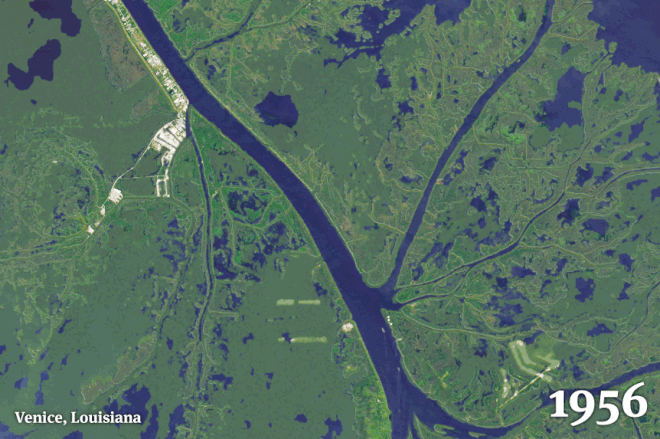
Speck by speck, land built over centuries
The coastal landscape Europeans found when they arrived at the mouth of the Mississippi River 500 years ago was the Amazon of North America, a wetlands ecosystem of more than 6,000 square miles built by one of the largest rivers in the world.
For thousands of years, runoff from the vast stretch of the continent between the Rockies and the Appalachians had flowed into the Mississippi valley. Meltwater from retreating glaciers, seasonal snowfall and rain carried topsoil and sand from as far away as the Canadian prairies. The river swelled as it rushed southward on the continent’s downward slope, toward the depression in the planet that would become known as the Gulf of Mexico.
Down on the flat coastal plain, the giant river slowed. It lost the power to carry those countless tons of sediment, which drifted to the bottom. Over thousands of years, this rain of fine particles gradually built land that would rise above the Gulf.
It wasn’t just the main stem of the Mississippi doing this work. When the river reached the coastal plain, side channels — smaller rivers and bayous — peeled off. They were called “œdistributaries,” for the job they did spreading that land-building sediment ever farther afield.
The delta had two other means of staying above the Gulf. The plants and trees growing in its marshes and swamps shed tons of dead parts each year, adding to the soil base. Meanwhile, storms and high tides carried sediment that had been deposited offshore back into the wetlands.
As long as all this could continue unobstructed, the delta continued to expand. But with any interruption, such as a prolonged drought, the new land began to sink.
That’s because the sheer weight of hundreds of feet of moist soil is always pushing downward against the bedrock below. Like a sponge pressed against a countertop, the soil compresses as the moisture is squeezed out. Without new layers of sediment, the delta eventually sinks below sea level.
The best evidence of this dependable rhythm of land building and sinking over seven millennia is underground. Geologists estimate that the deposits were at least 400 feet deep at the mouth of the Mississippi when those first Europeans arrived.
By the time New Orleans was founded in 1718, the main channel of the river was the beating heart of a system pumping sediment and nutrients through a vast circulatory network that stretched from present-day Baton Rouge south to Grand Isle, west to Texas and east to Mississippi. As late as 1900, new land was pushing out into the Gulf of Mexico.
A scant 70 years later, that huge, vibrant wetlands ecosystem would be at death’s door. The exquisite natural plumbing that made it all possible had been dismantled, piece by piece, to protect coastal communities and extract oil and gas.
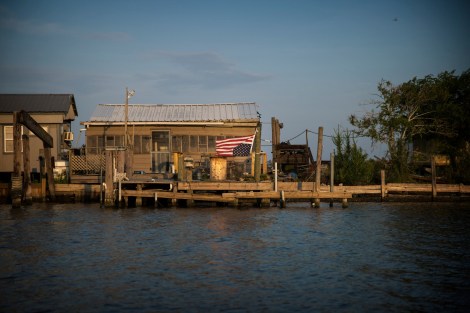
Edmund D. Fountain, Special to ProPublica/The Lens
Engineering the river
For communities along its banks, the Mississippi River has always been an indispensable asset and their gravest threat. The river connected their economies to the rest of the world, but its spring floods periodically breached locally built levees, quickly washing away years of profits and scores of lives. Some towns were so dependent on the river, they simply got used to rebuilding.
That all changed with the Great Flood of 1927.
Swollen by months of record rainfall across the watershed, the Mississippi broke through levees in 145 places, flooding the midsection of the country from Illinois to New Orleans. Some 27,000 square miles went under as much as 30 feet of water, destroying 130,000 homes, leaving 600,000 people homeless and killing 500.
Stunned by what was then the worst natural disaster in U.S. history, Congress passed the Flood Control Act of 1928, which ordered the U.S. Army Corps of Engineers to prevent such a flood from ever happening again. By the mid-1930s, the corps had done its job, putting the river in a straitjacket of levees.
But the project that made the river safe for the communities along the river would eventually squeeze the life out of the delta. The mud walls along the river sealed it off from the landscape sustained by its sediment. Without it, the sinking of land that only occurred during dry cycles would start, and never stop.
If that were all we had done to the delta, scientists have said, the wetlands that existed in the 1930s could largely be intact today. The natural pace of sinking — scientists call it subsidence — would have been mere millimeters per year.
But we didn’t stop there. Just as those levees were built, a nascent oil and gas industry discovered plentiful reserves below the delta’s marshes, swamps, and ridges.
At the time, wetlands were widely considered worthless — places that produced only mosquitoes, snakes, and alligators. The marsh was a wilderness where few people could live, or even wanted to.
There were no laws protecting wetlands. Besides, more than 80 percent of this land was in the hands of private landowners who were happy to earn a fortune from worthless property.
Free to choose the cheapest, most direct way to reach drilling sites, oil companies dredged canals off natural waterways to transport rigs and work crews. The canals averaged 13 to 16 feet deep and 140 to 150 feet wide — far larger than natural, twisting waterways.
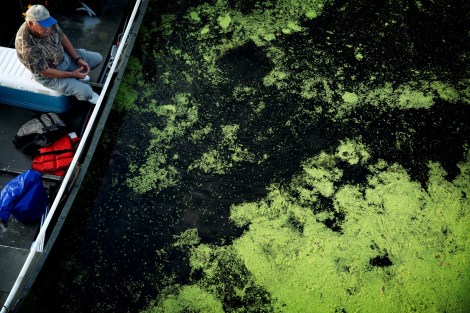
Edmund D. Fountain, Special to ProPublica/The Lens
Effects of canals ripple across the wetlands
Eventually, some 50,000 wells were permitted in the coastal zone. The state estimates that roughly 10,000 miles of canals were dredged to service them, although that only accounts for those covered by permitting systems. The state began to require some permits in the 1950s, but rigorous accounting didn’t begin until the Clean Water Act brought federal agencies into play in 1972.
Researchers say the total number of miles dredged will never be known because many of those areas are now underwater. Gene Turner, a Louisiana State University professor who has spent years researching the impacts of the canals, said 10,000 miles “would be a conservative estimate.”
Companies drilled and dredged all over the coast, perhaps nowhere more quickly than the area near Lafitte, which became known as the Texaco Canals.
This fishing village 15 miles south of New Orleans had been named for the pirate who used these bayous to ferry contraband to the city. For years, the seafood, waterfowl, and furbearers in the surrounding wetlands sustained the community. As New Orleans grew, Lafitte also became a favorite destination for weekend hunters and anglers.
Today those scenes are only a memory.
“Once the oil companies come in and started dredging all the canals, everything just started falling apart,” said Joseph Bourgeois, 84, who grew up and still lives in the area.
From 1930 to 1990, as much as 16 percent of the wetlands was turned to open water as those canals were dredged. But as the U.S. Department of the Interior and many others have reported, the indirect damages far exceeded that:
- Saltwater creeped in. Canal systems leading to the Gulf allowed saltwater into the heart of freshwater marshes and swamps, killing plants and trees whose roots held the soils together. As a side effect, the annual supply of plant detritus — one way a delta disconnected from its river can maintain its elevation — was seriously reduced.
- Shorelines crumbled. Without fresh sediment and dead plants, shorelines began to collapse, increasing the size of existing water bodies. Wind gained strength over ever-larger sections of open water, adding to land loss. Fishers and other boaters used canals as shortcuts across the wetlands; their wakes also sped shoreline erosion. In some areas, canals grew twice as wide within five years.
- Spoil levees buried and trapped wetlands. When companies dredged canals, they dumped the soil they removed alongside, creating “spoil levees” that could rise higher than 10 feet and twice as wide.The weight of the spoil on the soft, moist delta caused the adjacent marshes to sink. In locations of intense dredging, spoil levees impounded acres of wetlands. The levees also impeded the flow of water — and sediments — over wetlands during storm tides. If there were 10,000 miles of canals, there were 20,000 miles of levees. Researchers estimate that canals and levees eliminated or covered 8 million acres of wetlands.
All this disrupted the delta’s natural hydrology — its circulatory system — and led to the drowning of vast areas. Researchers have shown that land has sunk and wetlands have disappeared the most in areas where canals were concentrated.
In the 1970s, up to 50 square miles of wetlands were disappearing each year in the areas with heaviest oil and gas drilling and dredging, bringing the Gulf within sight of many communities.
As the water expanded, people lived and worked on narrower and narrower slivers of land.
“There’s places where I had cattle pens, and built those pens … with a tractor that weighed 5,000 or 6,000 pounds,” said Earl Armstrong, a cattle rancher who grew on the river nine miles south of the nearest road. “Right now we run through there with airboats.”
There are other forces at work, including a series of geologic faults in the delta and the rock layers beneath, but a U.S. Department of Interior report says oil and gas canals are ultimately responsible for 30 to 59 percent of coastal land loss. In some areas of Barataria Bay, said Turner at LSU, it’s close to 90 percent.
Even more damage was to come as the oil and gas industry shifted offshore in the late 1930s, eventually planting about 7,000 wells in the Gulf. To carry that harvest to onshore refineries, companies needed more underwater pipelines. So they dug wider, deeper waterways to accommodate the large ships that served offshore platforms.
Congress authorized the Corps of Engineers to dredge about 550 miles of navigation channels through the wetlands. The Department of Interior has estimated that those canals, averaging 12 to 15 feet deep and 150 to 500 feet wide, resulted in the loss of an additional 369,000 acres of coastal land.
Researchers eventually would show that the damage wasn’t due to surface activities alone. When all that oil and gas was removed from below some areas, the layers of earth far below compacted and sank. Studies have shown that coastal subsidence has been highest in some areas with the highest rates of extraction.
Push to hold industry accountable
The oil and gas industry, one of the state’s most powerful political forces, has acknowledged some role in the damages, but so far has defeated efforts to force companies to pay for it.
The most aggressive effort to hold the industry accountable is now underway. In July 2013, the Southeast Louisiana Flood Protection Authority-East, which maintains levees around New Orleans, filed suit against more than 90 oil, gas, and pipeline companies.
The lawsuit claims that the industry, by transforming so much of the wetlands to open water, has increased the size of storm surges. It argues this is making it harder to protect the New Orleans area against flooding and will force the levee authority to build bigger levees and floodwalls.
The lawsuit also claims that the companies did not return the work areas to their original condition, as required by state permits.
“The oil and gas industry has complied with each permit required by the State of Louisiana and the Corps of Engineers since the permits became law,” said Ragan Dickens, spokesman for the Louisiana Oil and Gas Association.
State leaders immediately rose to the industry’s defense. Much of the public debate has not been about the merits of the suit; instead, opponents contested the authority’s legal right to file the suit and its contingency fee arrangement with a private law firm.
“We’re not going to allow a single levee board that has been hijacked by a group of trial lawyers to determine flood protection, coastal restoration, and economic repercussions for the entire State of Louisiana,” said Gov. Bobby Jindal in a news release demanding that the levee authority withdraw its suit.
“A better approach,” he said in the statement, “to helping restore Louisiana’s coast includes holding the Army Corps of Engineers accountable, pushing for more offshore revenue sharing, and holding BP accountable for the damage their spill is doing to our coast.”
The industry’s political clout reflects its outsized role in the economy of one of the nation’s poorest states. The industry directly employs 63,000 people in the state, according to the federal Department of Labor.
Many of those employees live in the coastal parishes that have suffered most from oil and gas activities and face the most severe consequences from the resulting land loss.
Legislators in those areas helped Jindal pass a law that retroactively sought to remove the levee authority’s standing to file the suit. The constitutionality of that law is now before a federal judge.
Consequences now clear
Even as politicians fought the lawsuit, it was hard to deny what was happening on the ground.
By 2000, coastal roads that had flooded only during major hurricanes were going underwater when high tides coincided with strong southerly winds. Islands and beaches that had been landmarks for lifetimes were gone, lakes had turned into bays, and bays had eaten through their borders to join the Gulf.
“It happened so fast, I could actually see the difference day to day, month to month,” said Lambert, the fishing guide in Buras.
Today, in some basins around New Orleans, land is sinking an inch every 30 months. At this pace, by the end of the century this land will sink almost three feet in an area that’s barely above sea level today.
Meanwhile, global warming is causing seas to rise worldwide. Coastal landscapes everywhere are now facing a serious threat, but none more so than Southeast Louisiana.
The federal government projects that seas along the U.S. coastline will rise 1.5 to 4.5 feet by 2100. Southeast Louisiana would see “at least” 4 to 5 feet, said NOAA scientist Tim Osborn.
The difference: This sediment-starved delta is sinking at one of the fastest rates of any large coastal landscape on the planet at the same time the oceans are rising.
Maps used by researchers to illustrate what the state will look like in 2100 under current projections show the bottom of Louisiana’s “boot” outline largely gone, replaced by a coast running practically straight east to west, starting just south of Baton Rouge. The southeast corner of the state is represented only by two fingers of land — the areas along the Mississippi River and Bayou Lafourche that currently are protected by levees.
Finally, a plan to rebuild — but not enough money
Similar predictions had been made for years. But Hurricane Katrina finally galvanized the state legislature, which pushed through a far-reaching coastal restoration plan in 2007.
The 50-year, $50 billion Master Plan for the Coast (in 2012 dollars) includes projects to build levees, pump sediment into sinking areas, and build massive diversions on the river to reconnect it with the dying delta.
The state’s computer projections show that by 2060 — if projects are completed on schedule — more land could be built annually than is lost to the Gulf.
But there are three large caveats.
- The state is still searching for the full $50 billion. Congress so far has been unwilling to help.
- If the plan is to work, sea-level rise can’t be as bad as the worst-case scenario.
- Building controlled sediment diversions on the river, a key part of the land-building strategy, has never been done before. The predictions, then, are largely hypothetical, although advocates say the concept is being proven by an uncontrolled diversion at West Bay, near the mouth of the river.
Some of the money will come from an increased share of offshore oil and gas royalties, but many coastal advocates say the industry should pay a larger share.
In fact, leaders of the regional levee authority have said the purpose of the lawsuit was to make the industry pay for the rebuilding plan, suggesting that state could trade immunity from future suits for bankrolling it.
That idea is gaining momentum in official circles, despite the industry’s latest win in the state legislature.
Kyle Graham, executive director of the Louisiana Coastal Protection and Restoration Authority, said recently that the industry understands its liability for the crumbling coast and is discussing some kind of settlement. “It’s very difficult to see a future in which that [such an agreement] isn’t there,” he said.
Graham has said current funding sources could keep the restoration plan on schedule only through 2019. He was blunt when talking about what would happen if more money doesn’t come through: There will be a smaller coast.
“There are various sizes of a sustainable coastal Louisiana,” he said. “And that could depend on how much our people are willing to put up for that.”
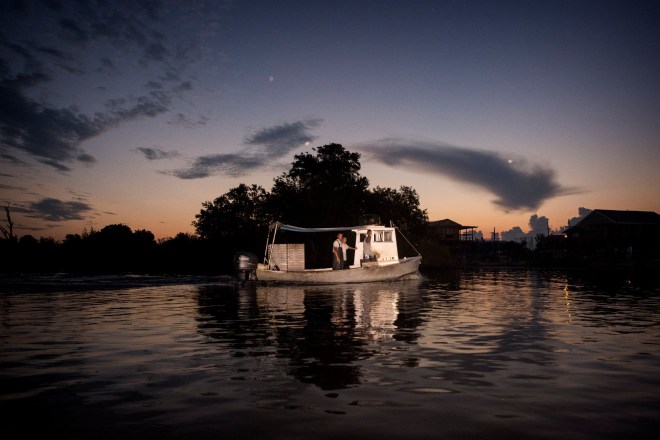
Edmund D. Fountain, Special to ProPublica/The LensDelacroix, La.
A vanishing culture
Trying to keep pace with the vanishing pieces of southeast Louisiana today is like chasing the sunset; it’s a race that never ends.
Lambert said when he’s leading fishing trips, he finds himself explaining to visitors what he means when he says, “This used to be Bay Pomme d’Or” and the growing list of other spots now only on maps.
Signs of the impending death of this delta are there to see for any visitor.
Falling tides carry patches of marsh grass that have fallen from the ever-crumbling shorelines.
Pelicans circle in confusion over nesting islands that have washed away since last spring.
Pilings that held weekend camps surrounded by thick marshes a decade ago stand in open water, hundreds of yards from the nearest land — mute testimony to a vanishing culture.
Shrimpers push their wing nets in lagoons that were land five years ago.
The bare trunks of long-dead oaks rise from the marsh, tombstones marking the drowning of high ridges that were built back when the river pumped life-giving sediment through its delta.
“If you’re a young person you think this is what it’s supposed to look like,” Lambert said. “Then when you’re old enough to know, it’s too late.”
For the full interactive experience, check out the story on ProPublica.
This story was written by Bob Marshall of The Lens. Data reporting, maps and design by Al Shaw of ProPublica and Brian Jacobs of Knight-Mozilla Open News. Photo research and audio production by Della Hasselle. Photography by Ellis Lucia of Knapp+Lucia Photography and Edmund D. Fountain.
Satellite-imagery training for this project was provided by the Tow Center for Digital Journalism at Columbia Journalism School.
Icons from The Noun Project: Zoom by Ryan Canning, Touch by Jakob Vogel and Map by Jose Moya.

